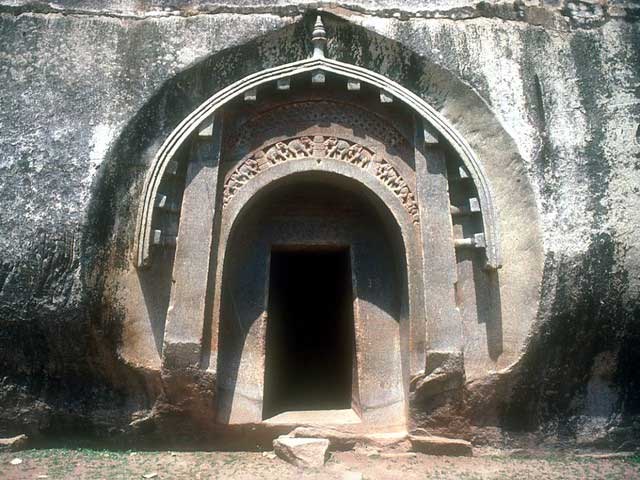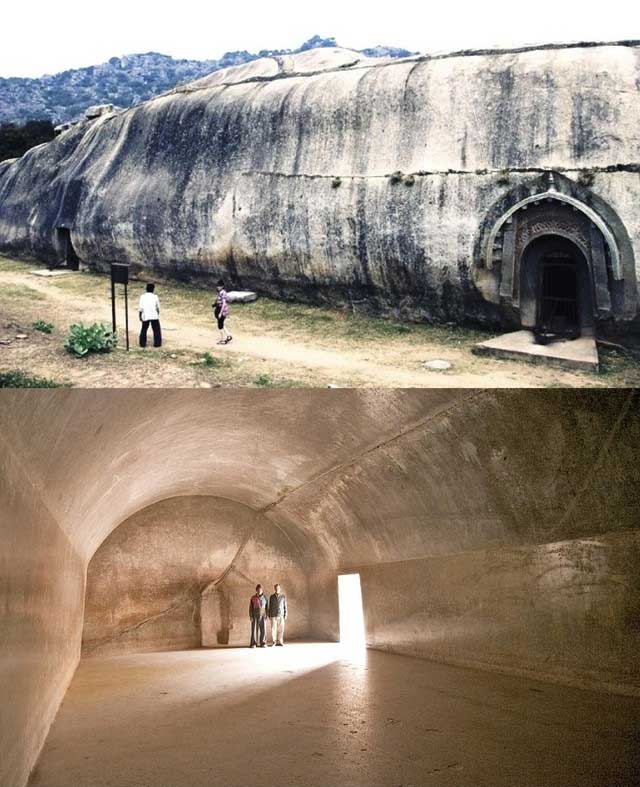In the region of Jehanabad, Bihar, India, there exists a mysterious monument of an ancient civilization – the Barabar Caves. This cave complex has not only shocked the world with its scale and design but has also sparked countless speculations due to the remarkable craftsmanship of ancient builders and its enigmatic purpose.
Carved from solid granite, this cave features an interior structure that is precisely symmetrical with perfect mathematical proportions, showcasing advanced craftsmanship and timeless mathematical knowledge. How did these ancient builders achieve such accuracy without modern tools? Where did their skill and knowledge originate? What is the true purpose of this cave?

The Barabar Caves actually consist of seven caves carved from solid granite. Each cave has a different interior shape, most of which contain two chambers. For instance, the Sudama Cave features a dome-shaped chamber and a rectangular chamber, while Karan Chopal has a rectangular chamber, and the Viskarkarma Cave contains two rectangular chambers. However, the most famous cave is Lomas Rishi Cave, which has a rectangular room measuring approximately 10 meters by 5 meters and a hemispherical room with a diameter of 5 meters.
Completely different from the style of ancient Indian architecture, the entrances to all the caves have a unique trapezoidal shape. One of the most impressive features of the Barabar Caves is their unique polished surface. The ancient builders polished the granite to such an extent that it creates an optical illusion of vitrified stone. Both the vaulted ceiling and the walls inside the cave exhibit an astonishing mirror-like effect. Researchers still do not fully understand how these polished surfaces inside the caves were created.
This indicates that the builders not only possessed advanced craftsmanship but also had profound mathematical knowledge. Firstly, they must have used tools similar to modern computers to plan the geometric dimensions and volumes, ensuring that the rooms were cut and shaped according to the plan during the carving process to achieve such perfect mathematical proportions.

The builders of the Barabar Caves clearly mastered technologies and knowledge that exceed our imagination. Even more astonishing, the geometric structure and spatial layout inside the caves contain complex mathematical ratios. These ratios are not merely random outcomes but products of careful calculation and design.
Firstly, the volume ratio of Karan Chopal and Gopika Cave is exactly 2:3, indicating that the builders not only understood the concept of volume but also could control the dimensions of the space accurately. This capability requires advanced mathematical understanding and computational techniques to ensure that every cut during the carving adhered to predetermined ratios.
Secondly, the volume ratio of Vadathika and Vapiyaka Caves is 7:8, while the volume ratio of the two chambers in Sudama Cave is 12:5. These ratios not only reflect the builders’ proficiency in mathematical ratios but may also suggest their awareness of the inherent proportions found in the universe and nature. In ancient cultures, mathematical ratios were often associated with cosmic order.

The design of the Barabar Caves not only reflects the calculations and craftsmanship of ancient artisans but also demonstrates their profound understanding of light and ventilation. The lighting and ventilation design of the caves still astonish modern scientists today.
Since the second chamber inside the cave is completely devoid of natural light, the builders must have used some form of strong light source to carry out the intricate carvings. However, traditional torches or candles would be nearly useless in such an environment as they do not provide sufficient illumination and produce a significant amount of smoke and soot. This suggests that the ancient craftsmen may have mastered some form of lighting technology that we are not yet aware of.
Moreover, the ventilation issue of the caves is equally perplexing. In a confined space, cutting granite would generate a significant amount of dust and silica particles, which, if not managed effectively, could pose serious health risks to workers. Therefore, the cave design must have included an efficient ventilation system to ensure a safe working environment.
In addition to lighting and ventilation, the acoustic design of the caves is also a mystery. The meticulous polishing of the cave walls not only offers visual beauty but may also enhance the reflection and resonance capabilities of sound waves. Specific angles and shapes inside the caves, such as the 88.5° incline, may be intended to create specific sound effects, such as focusing sound waves and enhancing resonant frequencies.
These designs suggest that the cave builders were not only concerned with creating a physical space but also sought to achieve some purpose through the power of sound. It may have been intended for meditation and prayer during religious rituals, or it could utilize the physical effects of sound to achieve practical functions. In either case, these designs reflect the ancient peoples’ profound understanding of the natural world and their clever use of technology.

Through research on the Barabar Caves, archaeologists speculate that these caves may have been constructed around 300 BC. This is because the walls feature inscriptions dating back to the time of Ashoka of the Mauryan Empire. However, there is a significant technological gap between the cave construction techniques and the inscriptions, which are much more rudimentary compared to the sophistication of the caves themselves, suggesting that the caves could be older than we think. Some archaeologists speculate that the caves may have been built by an ancient civilization, unknown to us, that was rediscovered and utilized during the reign of Ashoka.
Nevertheless, the knowledge and technology used in these caves were ahead of their time. Some scholars believe that the Barabar Caves might have been constructed for religious or spiritual purposes.

There are views that the Barabar Caves may relate to astronomy.
It is also suggested that the Barabar Caves might have been used as storage or shelter. There is an unfinished cave within the Barabar complex, which has led to much speculation. It is possible that a disaster or political unrest caused this interruption. There is also a viewpoint that the Barabar Caves may have connections to astronomy. The intricate craftsmanship and mathematical ratios of the caves may have been used to track the movements of the Sun, Moon, and stars. Each of these perspectives has its basis, but there are also doubts, and no conclusions have been drawn. Regardless, the intelligence and creativity of ancient humanity have far exceeded our imagination. They remind us that the caves may be hiding a part of forgotten ancient technology.


















































